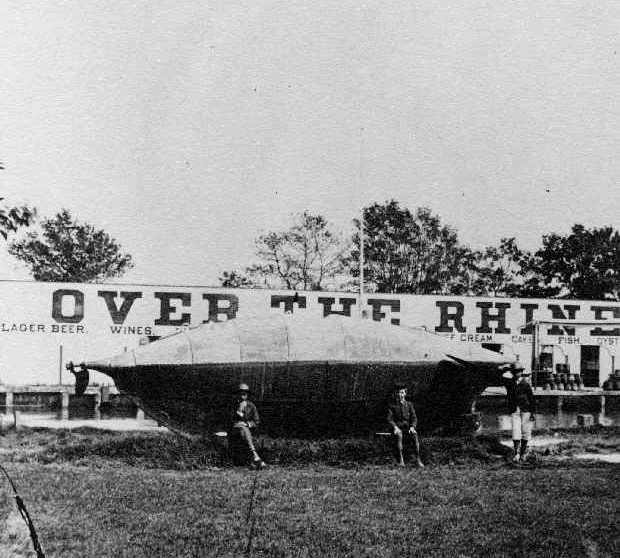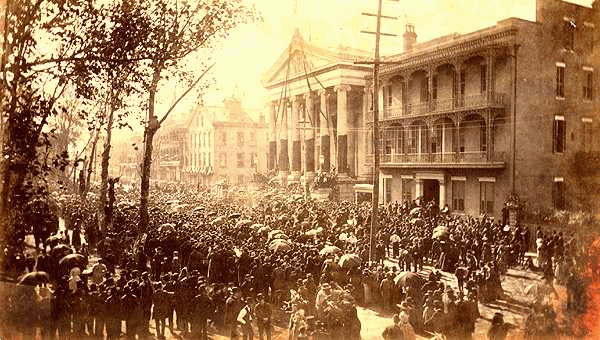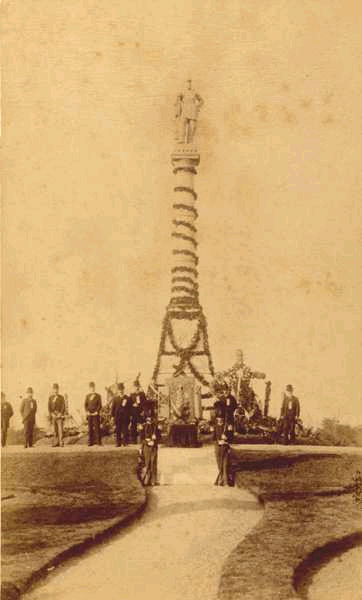|
December 11


Pat O'Brien's George Oechsner Jr. Dies December 11, 1990
During prohibition, North Carolina native Charlie Cantrell was running rum in Plaquemine.
He was also a master of the "Shake Up" which involved mixing grain alcohol with flavorings to create concoctions
tasting like gin, whiskey, rum, and other liquors. "Sometimes it wasn't too good, but it could get you drunk",
said Cantrell. Benson Harrison "Pat" O'Brien was a customer who bootlegged liquor back home to Birmingham.
They became friends. O'Brien, after several business endeavors, moved to New Orleans and ran a speakeasy.
After prohibition, on December 3, 1933 he opened a package liquor store at Royal and St. Peter Street. In 1934 he opened Club
Tipperary at 524 St. Louis. (The advertisement at the right ran in the Times-Picayune on March 18, 1934.) Cantrell financed
it. Then, as equal partners, they moved to another location in the 600 block of St. Peter Street across from the original
store. Cantrell later bought 10% of O'Brien's share, making him the controlling partner. In December, 1942 they
moved to the current location of the world famous Pat O'Brien's bar at 718 St. Peter and called it Pat O'Brien's. The building was historic long before Cantrell and O'Brien made it famous. Built in 1791, it housed
the first Spanish theater in the United States. The famous Hurricane cocktail was first mixed there 146 years later.
In 1937 a liquor salesman was hawking 60 bottles of rum at a bargain basement price and would even throw in 15 dozen glasses
shaped like the globes of oil fueled hurricane lamps. The rum wasn't selling as Cantrell had hoped, so he decided to experiment.
He mixed 4 ounces of it with red fruit juice and sugar, and instructed his waiters to tout these drinks. Customers loved them
and their glasses. Cantrell, a savvy businessman began selling both. That same year
(1937), Mercedes Paulson and Sue Wheeler first performed together at the dueling pianos (thought to be the first in the country).
"Sue" was actually Sara Belle Wheeler, a native of Vicksburg who had been educated in New Orleans. She passed
away on Saturday, March 10, 1956 at the age of 38 after having played at Pat O's for 19 years. Mercedes LeCorgne Paulson,
a native New Orleanian, died on Thursday, April 10, 1980 at the age of 74. Her booming baritone, which graced main bar
for 32 years, is still remembered by many. She retired from Pat O'Brien's in 1968. 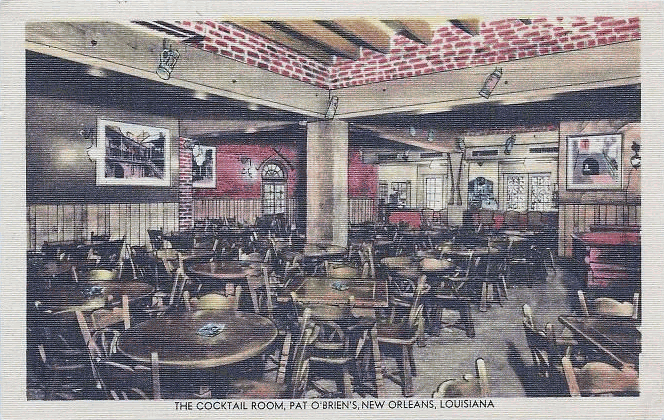 Charlie ran the business. Pat handled the customers. They were perfect partners for the business. During World War II,
Cantrell worked in a defense shipyard where he met George Oechsner, who would become the bars General Manager, taking Cantrell's
place and becoming part owner in 1947. In 1979 Oechsner's son George "Sonny" Jr. took over the role. It was
Sonny's idea to begin franchising and Pat O'Brien's bars sprouted up in Orlando, San Antonio, Memphis,
Cancun, and Destin. Sonny also added a restaurant upstairs, purchased a building on Bourbon Street for
expansion, opened a location at the Jaz Brewery, introduced an online catalog for selling branded items, and acquired a bottling
plant. The guys who ran the place for so many years are all gone now. Pat O'Brien died on
November 10, 1983. Geroge D. Oechsner Jr. followed on December 11, 1990. Charlie Cantrell passed away on March
23, 1993. Sonny died on March 12, 2012. But the business the two bootleggers started and the local men continued
remains, now an iconic New Orleans bar known around the world. Upon Sonny's death, his daughter
Shelly Oechsner Waguespack became Pat O'Brien's president and sole owner.
1947 postcard
|
|
On December 11, 2012, former NFL commissioner Paul Tagliabue, appointed to hear the
appeals, vacated all of the players' suspensions in the New Orleans Saints Bounty Scandal, saying that the coaches were primarily
responsible for the scheme. This announcement came after the 2012 Saints season when they finished with a losing record and
did not make the playoffs.
A storm, with a cold-core upper low, developed on December 11, 2012 behind the
first one and spread snow across parts of the Gulf Coast states including the cities of Houston, Texas, Baton Rouge, Louisiana
and New Orleans, Louisiana as well as parts of southern Mississippi. Four inches fell in Lumberton and Beaumont in southeast
Texas as well as just outside the Baton Rouge area and south central Louisiana. Some areas of west-central Louisiana received
as much as 6 inches, while areas just south of Jackson, Mississippi received 8 to 10 inches. It was the first snowfall
for the downtown New Orleans area since 2004 while its all-time snowfall record for one storm was 5 inches in December
1963. The winter weather caused local power outages in several parishes in Louisiana.
On December 11, 1971 Savoy Brown and Black Oak Arkansas performed at A Warehouse.
On December 11, 1944 the Liberty ships Andreas Honcharenko and Benjamin A. Fisher where
launched at Delta Shipbuilding Comany.
Born in New Orleans on December 11, 1897, Herbert William Christenberry attended
New York University and served in the United States Navy during World War I (1917 to 1918), received an LL.B. from Loyola
University New Orleans School of Law in 1924, and was in private practice in New Orleans from 1924 to 1933. He was an assistant
attorney of the Board of Commissioners, Port of New Orleans, Louisiana from 1933 to 1935. He was a deputy commissioner on
the Louisiana Debt Moratorium Commission in 1935, and was an assistant district attorney of the Parish of Orleans, Louisiana
from 1935 to 1937. He was an assistant U.S. Attorney of the Eastern District of Louisiana from 1937 to 1942, and was then
the United States Attorney for that district from 1942 to 1947. On July 11, 1947, Christenberry was nominated by President
Harry S. Truman to a seat on the United States District Court for the Eastern District of Louisiana vacated by Adrian J. Caillouet.
Christenberry was confirmed by the Senate on December 18, 1947, and received his commission on December 20, 1947. He served
as chief judge from 1949 to 1967, and continued on the court thereafter until his death on October 5, 1975
in Kentwood, Louisiana.
Civil War Submarine Donated to Soldier's Home on Bayou St. John December 11, 1909 A submarine constructed during the Civil War at Camp Nicholls was donated
by Camp Beauregard to the Old Soldier's Home on Bayou St. John on December 11, 1909. There has been much histoical confusion
about it and other under-water boats built at that time in our area: One,
believed to be the first built during the Civil War, was constructed at Spanish Fort in 1861-62. It sunk while being tested
in Bayou St. John resulting in the loss of three sailors’ lives. It was later dredged and
displayed near the Over the Rhine at the Spanish Fort resort. The February 15, 1868 New
Orleans Picayune, morning edition, reported: A torpedo boat, which was
built in this city...is to be sold at public auction today, by the United states
authorities....the boat....was sunk in the canal about the time
of the occupation of the city by federal forces, in 1862. It was built as an experiment and was never
fully perfected, and is only valuable now for the machinery and iron
which is in and about it.' The Picayune afternoon edition
claimed the torpedo boat was indeed sold as scrap...for $43. It was later located to the Spanish
Fort resort. From 1942 to 1953 the submarine was on display in Jackson Square. 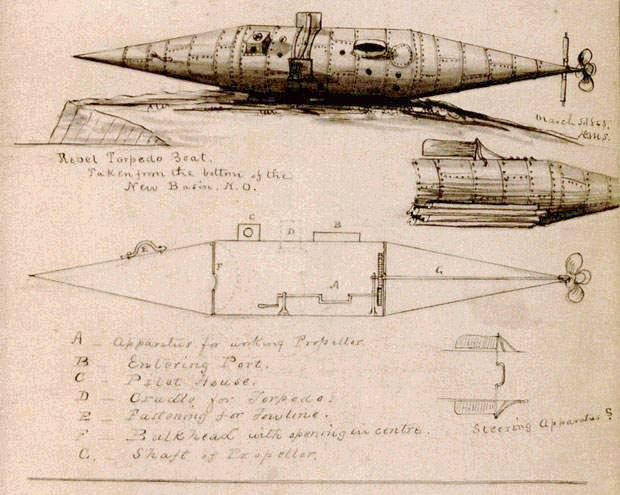 The Confederate submarine Pioneer drawn by Ensign David M. Stauffer
of the Mississippi Squadron, 1865. New Orleans, surrounded by water,
which has been our source of pleasure and pain, played a major part in the development of military submarines. At the
beginning of the Civil War, President Abraham Lincoln ordered a blockade of all Southern ports. To augment his own Navy,
Confederate President Jefferson Davis issued a proclamation inviting applications for letters of marque to encourage reprisal
against Federal ships and property. Respondents were drawn to the Algiers dockyards and to vessels suitable for refitting
as privateers.
Across the river at Leeds foundry, steam gauge manufacturers
James McClintock and Baxter Watson constructed a submarine to use against Union gunboats patrolling Lake Pontchartrain.
They would eventually partner with Horace L. Hunley, a wealthy lawyer and customs agent, to build a submarine with a menacing,
streamlined appearance. After the war, McClintock described the vessel he and his partners christened the Pioneer. - "…she was made of iron ¼
inch thick. The boat was of a cigar shape 30 feet long and 4 feet in diameter. This boat demonstrated to us that we could
construct a boat that would move at will in any direction desired, and at any distance from the surface. As we were unable
to see objects passing under the water, the boat was steered by compass…"
In March of 1862, the Pioneer's owners were granted a letter of marque by the Confederate government. A month later,
New Orleans fell to the West Gulf Blockading Squadron commanded by David Glasgow Farragut. In the ensuing turmoil, the
Pioneer was scuttled [deliberately sunk] in the New Basin Canal. The ship was quickly discovered in its watery grave
and brought to shore. A Federal team of experts was dispatched to examine the "infernal machine" and later submitted
their measured drawings to Fleet Engineer William Shock, who completed and forwarded them to Washington, D.C. for further
study.|
The Bayou St. John submarine at Spanish Fort amusement park, 1895
photograph by George F. Mugnier And yet another Civil War submarine was built here, this one on the
banks of Bayou St. John. Its history can be traced to 1878 when it was removed from Lake Pontchartrain and placed on the
levee by a dredge crew working near the mouth of Bayou St. John. For years after its recovery, the boat lay neglected
on the lakeshore. By 1895, it was placed on display at Spanish Fort where it became a prominent landmark. A period of
neglect followed, during which the submarine was taken from its wooden stand at the Fort and left lying in the weeds. A
remaining propeller blade was removed by vandals and large areas of loss appeared along the lower hull. Later, in 1908,
it was moved to the Camp Nicholls Confederate Home on Bayou St. John. In 1942, it was acquired by the State Museum and
moved to Jackson Square. Some years later the museum transferred it into the lower Pontalba Building, where it was featured
in a "Defense Exhibit." It was eventually moved under the Presbytere arcade in 1957 before being transferred
to the conservatory of the Louisiana State Museum in December of 1999. When restored, it will reside in the Baton
Rouge branch with exhibits on major events in Louisiana history. Interpretive text and displays will illustrate the vessel's
place in the State's maritime and Civil War history. 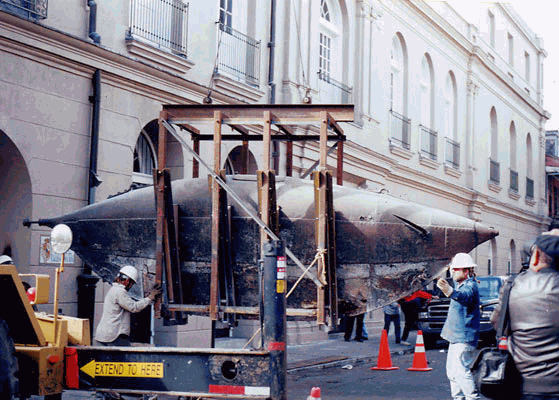 Submarine being transported to transferred to the conservatory of the
Louisiana State Museum in 1999 For decades, the vessel's identity had vexed researchers. Many thought the submarine was the Pioneer, the first
commissioned Confederate submarine that was constructed in New Orleans by the same group that later built the C.S.S. Hunley
- the famed submarine now undergoing conservation at the Warren Lasch Conservation Center in Charleston, S.C. However, a
drawing of the pioneer recently discovered in the National Archives by naval historian Mark Ragan illustrates that the State
Museum's submarine and the Pioneer are not the same vessel. A key player in the development of these hand-powered submarines was Confederate marine engineer
Horace Lawson Hunley. Born in Sumner County, Tennessee (on June 20, 1823) his parents (Louisa Harden Lawson and John
Hunley) relocated to New Orleans when he was a boy. Hunley served in the Louisiana State Legislature and practiced law
in New Orleans. In 1861, after the start of the war, he joined James R. McClintock and Baxter Watson in building the Pioneer.
The most famous of his boats was posthumously named for him, H. L. Hunley which played a small part in the American Civil
War, but a large role in the history of naval warfare as the first combat submarine to sink an enemy warship, the USS Housatonic.
Five men from the first crew of H. L. Hunley died during early tests when she was accidentally swamped by the wake of a
passing ship through her open hatches; four managed to escape. A second crew was recruited in Charleston. On October
15, 1863, though he was not part of the crew, Hunley decided to take command during a routine exercise. The vessel again
sank, and this time all eight crew members were killed, including Hunley himself. The vessel was later raised and used again
in the first successful sinking of an enemy vessel (the USS Housatonic (1861)) by a submarine in naval history, but the submarine
soon sank too. Horace L. Hunley was buried with full military honors at Magnolia Cemetery in Charleston, South Carolina,
on November 8, 1863. (Images and most text from the Louisiana State Museum)
Jefferson Davis' Funeral
December
11, 1889
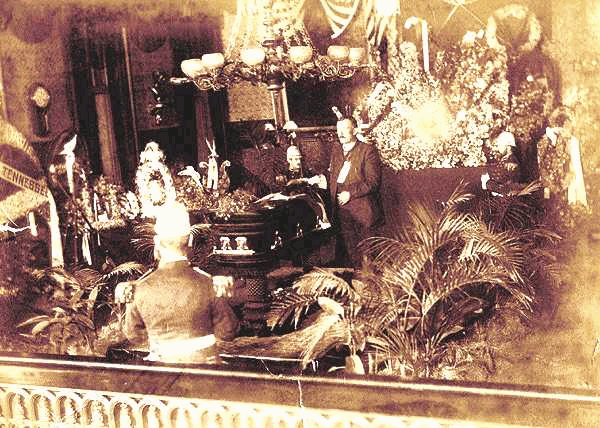 Jefferson Davis, former president of the Confederate States of American, died on December
6, 1889 at the New Orleans home of Associate Justice Charles E. Fenner, at the corner of First and Camp Streets.
Later that day his body was removed to the City Hall at Lafayette Square (now Gallier Hall), where the body lay in State
from Midnight, December 6 to Noon, December 11, 1889. Thousands of people filed past the coffin to look for
a last time upon the face of the man who had presided over the destinies of the Confederacy during the entire period of its
brief existence. The deceased was dressed in a suit of Confederate gray and the council chamber was profusely decorated with
the somber trappings bespeaking the gloom that dwelt in the hearts of the thousands to whom he was dear. The funeral services were held the at the entrance to the City Hall and it was one of the
most impressive ever held in the United States. The body was then carried by a funeral procession through the streets of New Orleans to Metairie
Cemetery. Davis was buried there in the tomb of the Army of Northern Virginia. On May 27, 1893, his
remains were transferred to a new casket and placed in state at Confederate Memorial Hall for a day before being removed to
the Louisville & Nashville train that carried them to Richmond, Virginia, for reinterment in the Hollywood Cemetery.
(From the New Orleans Public Library.)
 |
 |




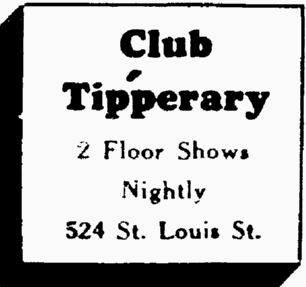
 Charlie ran the business. Pat handled the customers. They were perfect partners for the business. During World War II,
Cantrell worked in a defense shipyard where he met George Oechsner, who would become the bars General Manager, taking Cantrell's
place and becoming part owner in 1947. In 1979 Oechsner's son George "Sonny" Jr. took over the role. It was
Sonny's idea to begin franchising and Pat O'Brien's bars sprouted up in
Charlie ran the business. Pat handled the customers. They were perfect partners for the business. During World War II,
Cantrell worked in a defense shipyard where he met George Oechsner, who would become the bars General Manager, taking Cantrell's
place and becoming part owner in 1947. In 1979 Oechsner's son George "Sonny" Jr. took over the role. It was
Sonny's idea to begin franchising and Pat O'Brien's bars sprouted up in 

